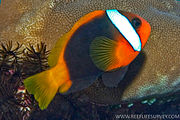| Tomato clownfish | |
|---|---|

| |
| Conservation status | |
 Least Concern (IUCN 3.1) | |
| Scientific classification | |
| Domain: | Eukaryota |
| Kingdom: | Animalia |
| Phylum: | Chordata |
| Class: | Actinopterygii |
| Order: | Blenniiformes |
| Family: | Pomacentridae |
| Genus: | Amphiprion |
| Species: | A. frenatus |
| Binomial name | |
| Amphiprion frenatus Brevoort, 1856 | |
| Synonyms | |
| |
The tomato clownfish (Amphiprion frenatus) is a species of marine fish in the family Pomacentridae, the clownfishes and damselfishes. It is native to the waters of the Western Pacific, from the Japan to Indonesia. Other common names include blackback anemonefish, bridled anemonefish, fire clown, and red tomato clown.
Characteristics of anemonefish
Main article: Amphiprioninae (anemonefish)Clownfish or anemonefish are fishes that, in the wild, form symbiotic mutualisms with sea anemones and are unaffected by the stinging tentacles of the host anemone, see Amphiprioninae § Symbiosis and mutualism. The sea anemone protects the clownfish from predators, as well as providing food through the scraps left from the anemone's meals and occasional dead anemone tentacles. In return, the clownfish defends the anemone from its predators, and parasites. Clownfish are small-sized, 10–18 centimetres (3.9–7.1 in), and depending on species, they are overall yellow, orange, or reddish or blackish color, and many show white bars or patches. Within species there may be color variations, most commonly according to distribution, but also based on sex, age and host anemone. Clownfish are found in warmer waters of the Indian and Pacific oceans and the Red Sea in sheltered reefs or in shallow lagoons.
In a group of clownfish, there is a strict dominance hierarchy. The largest and most aggressive fish is female and is found at the top. Only two clownfish, a male and a female, in a group reproduce through external fertilization. Clownfish are sequential hermaphrodites, meaning that they develop into males first, and when they mature, they become females.
Description

The adult fish is bright orange-red, with a white head bar or vertical stripe just behind the eyes, joined over the head and with a distinctive black outline. Females are mainly blackish on the sides. Males are considerably smaller and are red overall. Juveniles are a darker red, with two or three white bars. They have 9-10 dorsal spines, 2 anal spines, 16–18 dorsal soft rays and 13–15 anal soft rays. They reach a maximum length of 14 cm (5+1⁄2 in).
Color variations
The only color variation is sex related with females having darker coloration or dark spots on their sides.
Similar species
The Australian clownfish (A. rubrocinctus) has a similar coloration, however the female does not have the distinctive black outline of the white band, the band is poorly developed and may be discontinuous on top of the head. Geographic location is the easiest way to distinguish small juveniles as they are otherwise difficult to distinguish. The cinnamon clownfish (A. melanopus) is also similar, but has a broader white headbar and outside Melanesia it has black pelvic and anal fins.
-
 A. frenatus (Tomato anemonefish)
A. frenatus (Tomato anemonefish)
-
 A. rubrocinctus (Australian anemonefish)
A. rubrocinctus (Australian anemonefish)
-
 A. melanopus (Red & Black anemonefish)
A. melanopus (Red & Black anemonefish)
Distribution and habitat
This species is found as far north as Ryukyu Islands, Japan, to the South China Sea and surrounding areas including Malaysia and Indonesia.
Some authors report that this species is associated with a single species of anemone, the bubble-tip anemone (Entacmaea quadricolor). Other authorities report that it may be associated with the sebae anemone (Heteractis crispa), as well.
In aquaria
As a pet, many marine hobbyists agree that at least 20 US gallons (76 L) of tank volume is necessary for the fish, however others believe larger is necessary for this fish to have ample room for maneuvering. Many hobbyists use a quarantine tank prior to introduction into the main tank as it helps to rid the tomato clownfish of saltwater-borne diseases.
This species of fish thrives well even without a host anemone. In the absence of a host, it may "adopt" corals of a tank to reside. It will eat most meat or vegetable food preparations, including dried algae, mysis shrimp, and brine shrimp. The tomato clownfish has been reported to be aggressive and territorial when mature, and specimens have been known to be extremely aggressive even towards clownfishes of other species. For this reason, it is best kept singly or in mated pairs. It can be bred in captivity, and the fry can be fed on baby brine shrimp and rotifers.
References
- Jenkins, A.; Allen, G.; Myers, R.; Yeeting, B. & Carpenter, K.E. (2017). "Amphiprion frenatus". The IUCN Red List of Threatened Species. 2017: e.T188518A1886965. doi:10.2305/IUCN.UK.2017-2.RLTS.T188518A1886965.en.
- ^ Froese, R. and D. Pauly, Editors. Amphiprion frenatus. FishBase. 2015.
- Common names of Amphiprion frenatus. FishBase. 2015.
- "Clown Anemonefish". Nat Geo Wild : Animals. National Geographic Society. Archived from the original on January 13, 2010. Retrieved 2011-12-19.
- ^ Fautin, Daphne G.; Allen, Gerald R. (1992). Field Guide to Anemone Fishes and Their Host Sea Anemones. Western Australian Museum. p. 78. ISBN 978-0-7309-5216-9.
- ^ Lougher, T. (2006). What Fish?: A Buyer's Guide to Marine Fish. Interpet Publishing. p. 14. ISBN 978-0-7641-3256-8.
External links
- "Amphiprion frenatus". Integrated Taxonomic Information System. Retrieved 15 February 2006.
- Tomato Clownfish page at Animal World.
- Tomato Clownfish page at Stan & Debbie Hauter guide to Saltwater Aquariums.
- Photo of Tomato Clownfish in anemone, Astrolabe Reef, Kandavu, Fiji, at Walt and Mimi Miller's Ramblin' Cameras site.
- Photos of Tomato clownfish on Sealife Collection
| Taxon identifiers | |
|---|---|
| Amphiprion frenatus | |